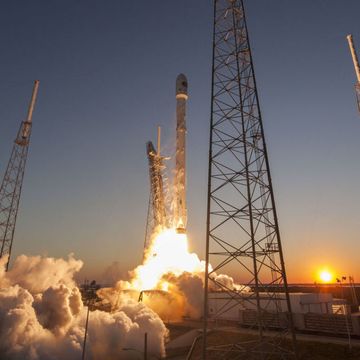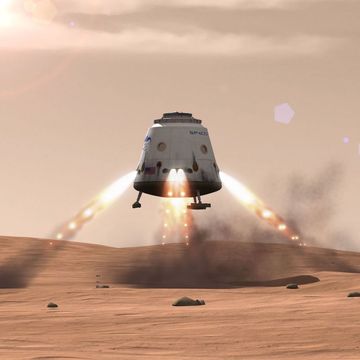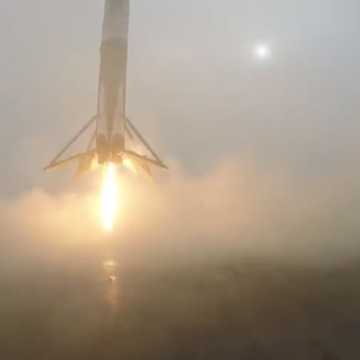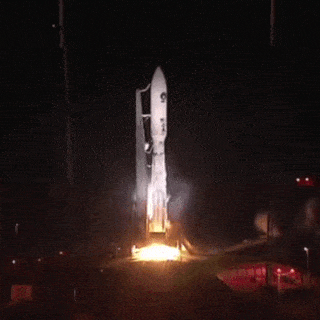UPDATE: Early on Sunday, SpaceX successfully linked up with the International Space Station.
UPDATE, Friday afternoon: SpaceX's Dragon capsule won't be linking up with the International Space Station on Saturday morning after all. But the company's leaders say the spacecraft is under control and its mission to the ISS should eventually go on.
SpaceX CEO Elon Musk and President Gwynne Shotwell joined NASA's William Gerstenmaier and ISS program manager Michael Suffredini for a press conference this afternoon to address the problems the Dragon capsule experienced after reaching orbit this morning, when its Draco thrusters failed to activate. The Dragon itself is in orbit, holding steady until its operators ensure they are in complete control of it and are ready to attempt the link-up to the ISS. "We put the vehicle where we wanted it to go," Shotwell says. "It's in orbit and is stable" Two of the four pods of thrusters are currently working normally, Musk says. The other two are looking good but not online yet.
"We're definitely not going to rush it. It was a little frightening there," Musk says. "There's no leakage, debris of fluid leakage we know of. All systems seem to be intact and functioning at this point. We're hoping it stays that way."
Musk was cautious about citing a cause of the thruster malfunction. One possibility is that a blockage of frozen oxidizer, nitrogen tetroxide, stopped the tanks from pressurizing, though all the oxidizer tanks are now holding pressure, Musk says.
SpaceX and NASA won't say for now when they'll attempt to berth Dragon with the ISS. First, they'll fire the Dragon's thrusters to move it closer to the station, and to make sure it's responding to commands. "We will have confirmed that we are comfortable" before the berthing will be attempted, NASA's Gerstenmaier says. Then meet-up will need to happen before March 15, when the current ISS crew is scheduled to swap out. "Once we're sure things are well understood and NASA is comfortable, it could be a fairly rapid series of burns to get close to the space station," Musk says.
Test-fire of a Draco thruster. Credit: SpaceX
Today's SpaceX rocket launch, sending supplies to the International Space Station aboard the Dragon capsule, looked perfect off the launch pad. But the mission ran into trouble with the Dragon, which is supposed to dock with the ISS Saturday morning.
The problem appears to be with small engines that steer the craft while in space. The capsule separated successfully and was about to deploy its solar panels when the small engines, called Draco thrusters, failed to activate. There are 18 Draco thrusters on the Dragon that SpaceX uses to control the spacecraft in orbit and to steer it to the correct reentry location. They are not very powerful, producing just 90 pounds of thrust each, but they are vital to the spacecraft's operation.
Engines like these are installed on bases called pods that determine when they fire. SpaceX CEO Elon Musk first tweeted that there was an "Issue with Dragon thruster pods. System inhibiting three of four from initializing." This meant that the engines themselves were working, but the devices that steer them malfunctioned. SpaceX officials saw that the problem could be solved with a software command rather than a hardware fix. "About to pass over Australia ground station and command inhibit override," Musk tweeted later. Within about an hour of Musk's first update, he said, "Thruster pod 3 tank pressure trending positive. Preparing to deploy solar arrays." (The company says two working thruster pods are needed to steer the craft, through Dragon is dual-redundant in all axes; any two can fail and still have complete vehicle control.) SpaceX has now deployed the solar arrays, and the mission is getting back to normal.
The Draco engines will be replaced in future human-rated capsules. Eight SuperDraco engines, producing up to 120,000 pounds of thrust, will replace the 18 smaller ones. The new engines will handle maneuvering, de-orbit burns, and re-entry attitude adjustments. They also will have the power to serve as an emergency escape system for astronauts during launch.
Head over to NASA's website for more updates.
Joe Pappalardo is a contributing writer at Popular Mechanics and author of the new book, Spaceport Earth: The Reinvention of Spaceflight.









